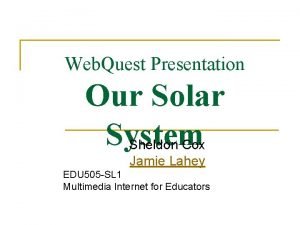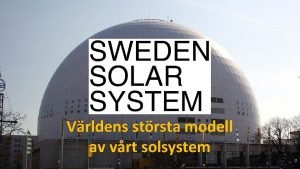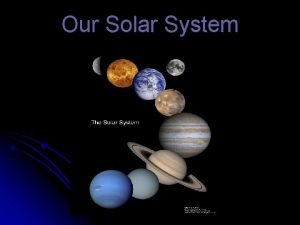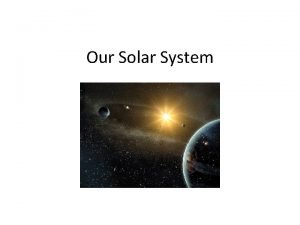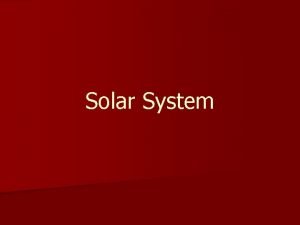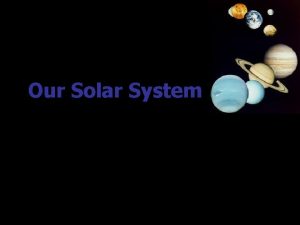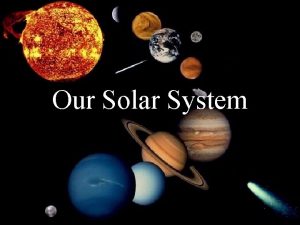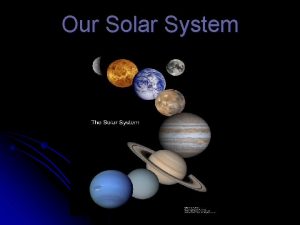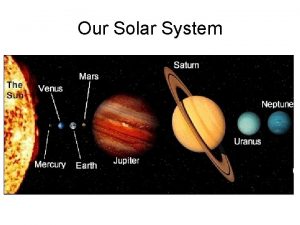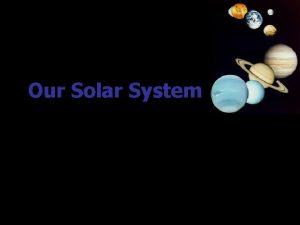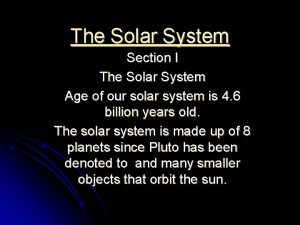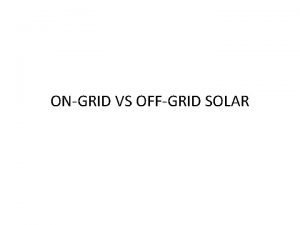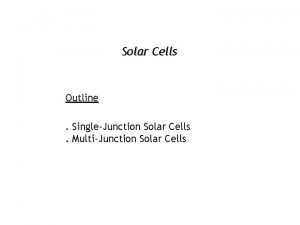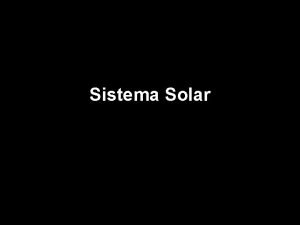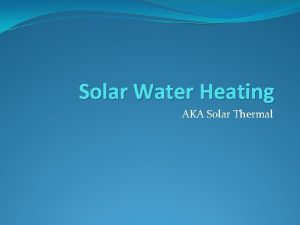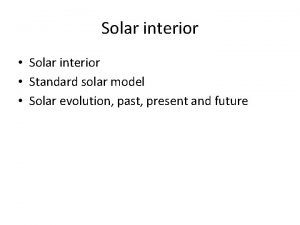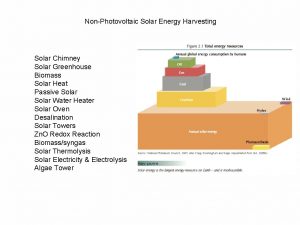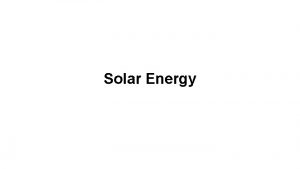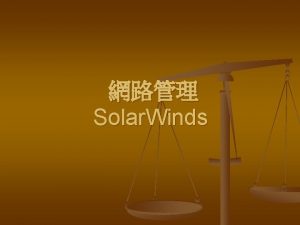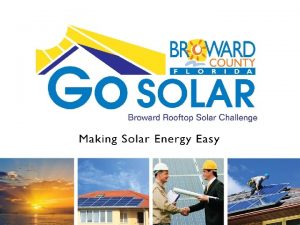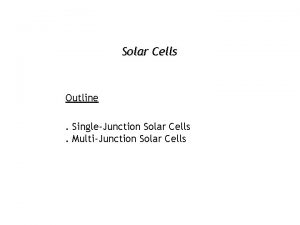The Solar System Section 1 The Solar System


















































- Slides: 50

The Solar System

Section 1 The Solar System A. Ideas about the night sky have changed over time. 1. Earth-centered model—early Greeks thought planets, Sun, Moon, and stars rotated around Earth.

2. Sun-centered model—Nicholas Copernicus and Galileo Galilei observed that the Moon revolved around Earth and that Earth and the other planets revolved around the Sun.

3. Modern view—solar system includes Sun, nine planets, many small objects, and a huge volume of space. a. Sun is the center of the solar system b. All other objects in the solar system revolve around the Sun.

B. How the solar system formed 1. A nebula of gas, ice, and dust slowly formed in space 2. A cloud of material in the nebula slowly rotated in space. 3. Shock waves might have caused the cloud to contract, and the matter was squeezed into less space.


4. The cloud became more dense, rotated faster, heated up, and flattened to form a disk 5. As the cloud contracted, it grew warmer, triggering a nuclear fusion reaction that created the Sun.

6. The leftover matter became the planets and asteroids. a. First four inner planets—small and rocky with iron cores b. Last five outer planets—large and lightweight except for Pluto

C. Planet motion 1. Copernicus—planets had circular orbits around the Sun.

2. Johannes Kepler—German mathematician a. Discovered that the planet orbits were elliptical and that the Sun was not directly in the center of the orbits b. Determined that planets do not orbit the Sun at the same speed


�DISCUSSION QUESTION: �Why is the Sun at the center of the solar system?

�It is by far the densest object in the solar system.

Section 2 The Inner Planets A. Mercury—closest to the Sun, second-smallest planet 1. Weak magnetic field suggests an iron core 2. Has many craters and high cliffs 3. No true atmosphere, so surface temperatures range from very hot to very cold


B. Venus—second from the Sun and similar to Earth in size and mass 1. Extremely dense atmosphere of clouds 2. Carbon dioxide gas traps solar energy. a. Causes an intense greenhouse effect b. Results in surface temperatures between 450°C and 475°C


C. Earth—third planet from the Sun 1. Average distance between Earth and the Sun is 150 million km 2. Water exists on surface as solid, liquid, and gas. 3. More than 70 percent of surface covered with water 4. Atmosphere protects surface from most meteors and Sun’s radiation


D. Mars—fourth planet from the Sun 1. Called red planet because iron oxide in rocks makes them reddish-yellow 2. Polar ice caps made mostly of frozen carbon dioxide and frozen water 3. Has largest volcano in the solar system 4. Soil shows no evidence of life.


5. Has gullies and deposits of soil and rocks, which may indicate the presence of liquid groundwater 6. Thin atmosphere of mostly carbon dioxide

7. Strong winds caused by differences in temperature between day and night 8. Is tilted on its axis, which causes seasons 9. Two small moons: Phobos and Deimos

DISCUSSION QUESTION: �What does a planet’s atmosphere do?

�Protect planet surface from meteors, Sun’s radiation; moderates temperature

Section 3 The Outer Planets

A. Jupiter—fifth planet from the Sun, largest planet in the solar system 1. Atmosphere— primarily hydrogen and helium a. Below atmosphere, liquid hydrogen and helium are suspected. b. Solid rocky core may exist below liquid level. c. The Great Red Spot is the most spectacular of Jupiter’s many constant highpressure gas storms.


2. Has at least 61 moons—four are relatively large and have atmospheres a. Io—is very volcanically active; the closest large moon to Jupiter b. Europa—composed mostly of rock; may have an ocean of water under a thick layer of ice c. Ganymede—largest moon in solar system, even larger than planet Mercury d. Callisto—cratered rock and ice crust may surround a salty ocean and rock core

B. Saturn—sixth planet from the Sun, second largest in the solar system, lowest density 1. Thick outer atmosphere of hydrogen, helium, ammonia, methane, and water vapor 2. Might have a small, rocky core

3. Each large ring composed of thousands of ringlets of ice and rock particles 4. Has at least 31 moons a. Largest moon, Titan, is larger than the planet Mercury. b. Thick clouds on Titan prevent scientists from seeing surface.

C. Uranus—seventh planet from the Sun, large and gaseous 1. Has thin, dark rings 2. Atmosphere of hydrogen, helium, and methane 3. Methane makes the planet bluish-green in color. 4. Axis of rotation nearly parallel to plane of orbit


D. Neptune—usually the eighth planet from the Sun, large and gaseous 1. Bluish-green-colored atmosphere similar to that of Uranus 2. Storms on Neptune reveal an active and rapidly changing atmosphere 3. Has at least 11 moons, of which pinkish Triton is largest


E. Pluto—usually the ninth planet from the Sun, occasionally closer to the Sun than Neptune, smallest planet in the solar system 1. Has a thin atmosphere and a solid, rocky surface


2. Discovered in 1978, moon Charon is half the planet’s size. 3. Hubble Space Telescope reveals group of icy comets named Kuiper Belt beyond Neptune’s orbit.

DISCUSSION QUESTION: What characteristics of Pluto make it different from the other outer planets?

Small size, thin atmosphere, single moon, solid surface

Section 4 Other Objects in the Solar System

A. Comet—dust and rock particles combined with frozen water, methane, and ammonia 1. Halley’s comet orbits the Sun every 76 years. 2. Oort Cloud—large group of comets surrounding solar system beyond Pluto 3. Amateur astronomers discovered Comet Hale-Bopp in 1995

4. Comet structure—large dirty snowball of frozen rock and ice a. Ice and dust vaporize as comet nears Sun. b. Vaporized material forms bright cloud called coma around comet nucleus. c. Solar wind pushes on gas and dust in the coma, causing the particles to form a tail that always points away from the Sun. d. Eventually, most of the ice in the comet’s nucleus vaporizes, leaving only small particles.


B. Small pieces of the old comet’s nucleus 1. Meteoroid—name given to small pieces of comet when they move through space 2. Meteor—small meteoroid that burns up in Earth’s atmosphere 3. Meteor showers—occur when Earth’s orbit passes through a group of meteoroids that enter the atmosphere 4. Meteorite—meteoroid that strikes Earth

C. Asteroid—rock similar to that which formed planets 1. Most asteroids lie in an asteroid belt located between Mars and Jupiter. 2. Jupiter’s gravity may have kept these asteroids from forming a planet.


3. Some planets’ moons may be asteroids pulled from the asteroid belt. 4. Asteroid sizes range from very tiny to 940 km in diameter. 5. The Near Earth Asteroid Rendezvous probe indicates asteroid 433 Eros has been in many collisions over time.

DISCUSSION QUESTION: What likely caused craters on the surfaces of planets and moons?

Collisions with meteoroids or asteroids
 Solar cells wholesale
Solar cells wholesale An inexhaustible source of energy
An inexhaustible source of energy Hình ảnh bộ gõ cơ thể búng tay
Hình ảnh bộ gõ cơ thể búng tay Lp html
Lp html Bổ thể
Bổ thể Tỉ lệ cơ thể trẻ em
Tỉ lệ cơ thể trẻ em Chó sói
Chó sói Chụp tư thế worms-breton
Chụp tư thế worms-breton Hát lên người ơi
Hát lên người ơi Môn thể thao bắt đầu bằng chữ f
Môn thể thao bắt đầu bằng chữ f Thế nào là hệ số cao nhất
Thế nào là hệ số cao nhất Các châu lục và đại dương trên thế giới
Các châu lục và đại dương trên thế giới Công thức tiính động năng
Công thức tiính động năng Trời xanh đây là của chúng ta thể thơ
Trời xanh đây là của chúng ta thể thơ Mật thư anh em như thể tay chân
Mật thư anh em như thể tay chân Làm thế nào để 102-1=99
Làm thế nào để 102-1=99 Phản ứng thế ankan
Phản ứng thế ankan Các châu lục và đại dương trên thế giới
Các châu lục và đại dương trên thế giới Thơ thất ngôn tứ tuyệt đường luật
Thơ thất ngôn tứ tuyệt đường luật Quá trình desamine hóa có thể tạo ra
Quá trình desamine hóa có thể tạo ra Một số thể thơ truyền thống
Một số thể thơ truyền thống Cái miệng nó xinh thế
Cái miệng nó xinh thế Vẽ hình chiếu vuông góc của vật thể sau
Vẽ hình chiếu vuông góc của vật thể sau Thế nào là sự mỏi cơ
Thế nào là sự mỏi cơ đặc điểm cơ thể của người tối cổ
đặc điểm cơ thể của người tối cổ Thứ tự các dấu thăng giáng ở hóa biểu
Thứ tự các dấu thăng giáng ở hóa biểu Vẽ hình chiếu đứng bằng cạnh của vật thể
Vẽ hình chiếu đứng bằng cạnh của vật thể Vẽ hình chiếu vuông góc của vật thể sau
Vẽ hình chiếu vuông góc của vật thể sau Thẻ vin
Thẻ vin đại từ thay thế
đại từ thay thế điện thế nghỉ
điện thế nghỉ Tư thế ngồi viết
Tư thế ngồi viết Diễn thế sinh thái là
Diễn thế sinh thái là Dạng đột biến một nhiễm là
Dạng đột biến một nhiễm là So nguyen to
So nguyen to Tư thế ngồi viết
Tư thế ngồi viết Lời thề hippocrates
Lời thề hippocrates Thiếu nhi thế giới liên hoan
Thiếu nhi thế giới liên hoan ưu thế lai là gì
ưu thế lai là gì Hổ sinh sản vào mùa nào
Hổ sinh sản vào mùa nào Khi nào hổ mẹ dạy hổ con săn mồi
Khi nào hổ mẹ dạy hổ con săn mồi Hệ hô hấp
Hệ hô hấp Từ ngữ thể hiện lòng nhân hậu
Từ ngữ thể hiện lòng nhân hậu Thế nào là mạng điện lắp đặt kiểu nổi
Thế nào là mạng điện lắp đặt kiểu nổi Section view
Section view Example of revolved section
Example of revolved section Viewing plane line
Viewing plane line Section 2 describing energy worksheet answers
Section 2 describing energy worksheet answers Chapter 10 section 1 meiosis worksheet answer key
Chapter 10 section 1 meiosis worksheet answer key Solar system webquest answer
Solar system webquest answer Solar system sweden
Solar system sweden

















































